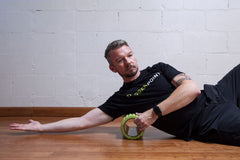No Products in the Cart

Have you ever been in the gym and seen those weird black foam tubes that everyone is laying on? That was me for 2 years in the gym not realizing what I was missing out on. That my friends, is foam rolling. However, now that I am educated, I realize that I see some people foam rolling incorrectly. Most think that you just roll over the spots that hurt and you just roll out the pain. As you will soon find out, that is wrong, and I will explain the correct way on how to foam roll.
First, we must talk about the science behind foam rolling. This helped me understand why you are supposed to do what you do. Foam rolling is also known as self-myofascial release or SMR. SMR excites your Golgi Tendon Organ (GTO), or part of your muscle that responds to muscle tension. When it is stimulated it tells your muscles to relax and loosen up. Basically, you put pressure on it and it tells your muscle to chill so you don’t hurt yourself. A common misconception is that foam rolling is for recovery and sore muscles, however this is incorrect, sort of. Foam rolling is more for flexibility and making sure that your muscles are at their proper length before and after exercise. The reason we think it is for recovery is because our muscles feel tight after a workout and we want to ‘push out the lactic acid’. However, this is not the case, foam rolling will only help lengthen the tight muscle which may promote increased blood flow, but you are not pushing out the soreness.
Now, the correct way to foam roll. First you need to get a hard-enough object that it can put enough pressure on the muscle that is too tight. Then you roll on the target muscle until it hits a ‘knot’, or a place where your muscle is bundled up and it is painful. Next, you put your weight on that area and hold for one minute. This will be painful, but it is only for a short period of time. To relieve some pain, you may pulse on the area slightly to take off some pressure, but the more is better. After the minute, your muscle will relax and return to normal. You can foam roll on any muscle, but try to ensure that there is one point of contact and that is on the tight spot, not across the entire muscle.